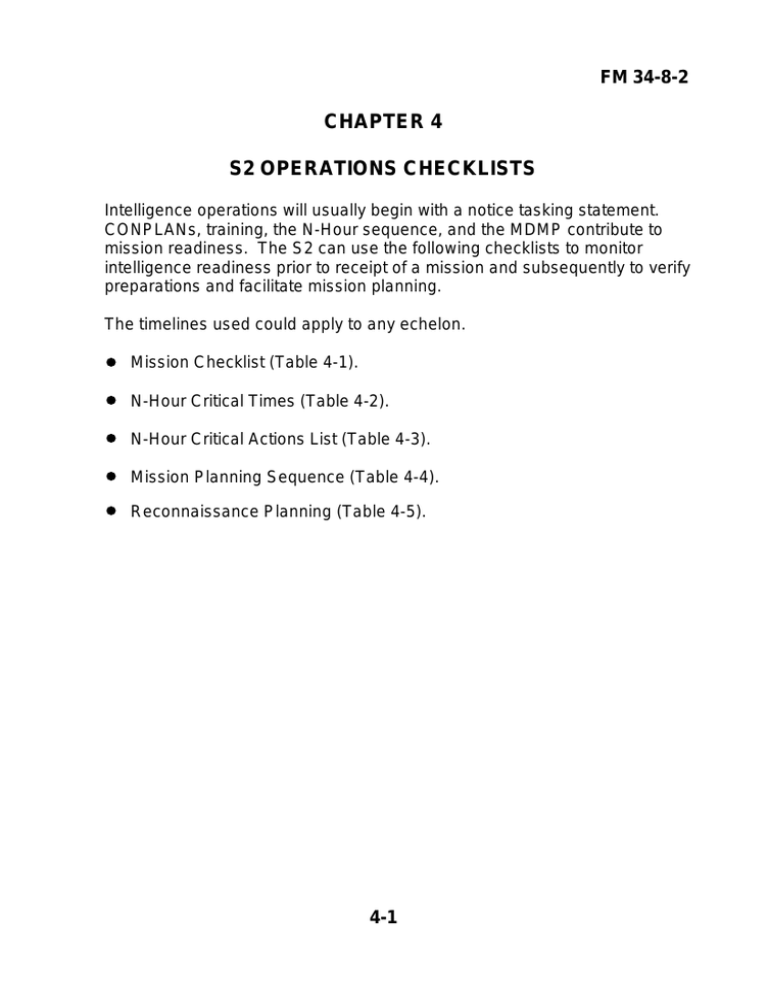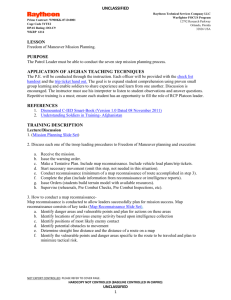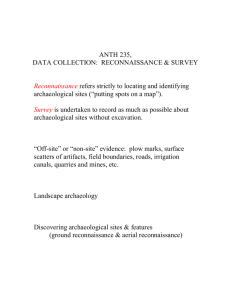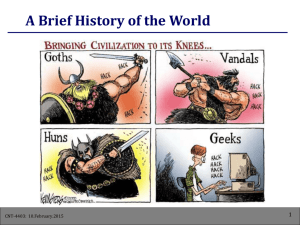CHAPTER 4 S2 OPERATIONS CHECKLISTS FM 34-8-2
advertisement

FM 34-8-2 CHAPTER 4 S2 OPERATIONS CHECKLISTS Intelligence operations will usually begin with a notice tasking statement. CONPLANs, training, the N-Hour sequence, and the MDMP contribute to mission readiness. The S2 can use the following checklists to monitor intelligence readiness prior to receipt of a mission and subsequently to verify preparations and facilitate mission planning. The timelines used could apply to any echelon. Mission Checklist (Table 4-1). N-Hour Critical Times (Table 4-2). N-Hour Critical Actions List (Table 4-3). Mission Planning Sequence (Table 4-4). Reconnaissance Planning (Table 4-5). 4-1 FM 34-8-2 Table 4-1. Mission checklist . Mission Day Minus ACTION A-28 Notify attachments to provide updated access rosters prior to A-Day. REMARKS Provide open access to national and strategic databases. Initiate verification of clearances within battalion. Include sensitive positions and RTOs. Coordinate security briefings for unit personnel. Include all OPSEC program components and SAEDA program. Coordinate contingency AI briefings. A-21 Verify access to intelligence databases through division or higher. Disseminate hard copy products to subordinate units. Inspect unit areas and equipment for physical security deficiencies. Coordinate for support and access. Check equipment compatibility. Review section files. Designate deployable and nondeployable records. Obtain current TECHINT/User Bulletins and DIA Top Ten Equipment Acquisition list from 203d MI Bn (TECHINT). Acquire information on disposition directives from JCS and theater commander. Obtain higher HQ access roster. Update as required throughout mission cycle. Coordinate security force requirements with tasked units and MP. Identify linguists in unit or update current file. Provide list, crosscheck with S1 data. Provide updated list of telephone numbers to be cut off at N+2 to the S1. A-14 Finalize security plans and instructions. Check guard/MP patrols. A-8 Coordinate security requirements for filler personnel. Barrier material, lighting, container seals, security of vehicle holding area, motor pool, empty barracks. 4-2 FM 34-8-2 Table 4-1. Mission checklist (continued). Mission Day Minus ACTION A-8 Prepare DA Form 3964 for classified material transported with deploying elements. REMARKS Brief MI battalion LNO on duties. A-7 Finalize MI battalion personnel and equipment support list. Ensure copy placed in SDO book. Update section alert notification roster. Continually monitor intelligence WATCHCON levels. A-4 Check alert rosters in SDO book and completion of all unit OPSEC and SAEDA briefings. A-Day Brief RDC on battalion security plan. EEFI material, handle accordingly. Issue guard instructions. Provide access rosters to rear detachment personnel, higher and supported HQ. 4-3 FM 34-8-2 Table 4-2. N-Hour critical times. N-Hour EVENT N-Hour Notify and assemble units. REMARKS Initiate telephone control. Initiate area security plan. List questions for N+2 brief. N+1:30 Prepare staff equipment to go to staging area. Verify basic load, load plans. N+1:45 Maps, batteries, etc. Depart for N+2 brief location. Distribute updated access roster. Secure battalion conference room. N+2:00 Present N+2 briefing. Coordinate with CI to initiate OPSEC plan; inspect battalion area for physical security violations. N+3:30 Present the intelligence estimate. N+3:45 Confirm transfer of company arms room keys to the rear detachment S2 before departing to staging area. Verify security clearances of attachments through supporting S2. N+4:30 Sweep battalion area with CI personnel. N+5:00 Impose restrictions on incoming/ outgoing mail. N+6:30 Issue OPORD at staging area. N+8:00 Ensure rear detachment is briefed on security. When given proper authority. Provide latest intelligence update to commander and staff. Have LNOs, DS MI CDR attend. NOTE: Modify times depending on mission requirements and SOPs. 4-4 FM 34-8-2 Table 4-3. N-Hour critical actions list. H-HOUR ACTION ACTION OFFICER(S) ______ Mission Receipt 1 ______ WARNO-------------------------------------------- ______ Do IPB---------------------------------------------- CDR, S2/S3 S2 (w/asst from ENGR, Terrain, Weather, etc) 2 2 2 3 4 5 6 ______ ______ ______ ______ ______ ______ ______ ______ ______ Mission Analysis Brief Mission to CDR---------------------------Initial CDR's Guidance Do COAs------------------------------------------Staff IPB & COAs-------------------------------Do Staff Estimates------------------------------COA Analysis (wargaming)-------------------Select Best COA--------------------------------Do DST--------------------------------------------- 5 7 7 ______ ______ ______ ______ 8 8 8 9 10 11 ______ ______ ______ ______ ______ ______ 12 13 14 14 15 16 17 17 17 18 19 ______ ______ ______ ______ ______ ______ ______ ______ ______ ______ ______ ______ Brief DST Brief Selected COA------------------------------ Selected Staff CDR's Decision WARNO Scouts/Patrols Recon--------------- S2/Asst S2/BICC officer/S3 Mission Brief OPORD Prep/Staff Coord---------------------- Unit Staff Turn in OPORD Annex Proof OPORD Issue Targeting Overlay------------------------- FSO Brief Scouts/Patrols Recon--------------------- S2/Asst S2/BICC officer/S3/ENGR/FSO/ADA Execution Matrix---------------------------------- S3 BOS Synchronization Matrix----------------Unit Staff Maps/Charts Prep-------------------------------- Unit Staff CDR's Map Updated---------------------------- S2/S3 OPORD Rehearsal------------------------------ XO, S3 OPORD Briefing---------------------------------- XO Initial Backbrief TF CDR Brief Higher HQ---------------------- CDR, S2, S3 Co/Bn CDR Backbrief Rehearsal------------------------------------------ Unit Staff, CDR Final INTEL Update----------------------------- S2 LD/LC Coordinating Staff CDR, S2/S3 S2, S3 Unit Staff CDRs, Unit Staff S3, Selected Staff S2/S3, FSO, ADA, ENGR, SIG, CHEM NOTE: These items are not listed in a definite order; some may not occur at all. 4-5 FM 34-8-2 Table 4-4. Mission planning sequence . S2 ACTIONS UPON RECEIPT OF A MISSION: 1. Receive and analyze mission: - Receive CDR's guidance and assist in development of CDR's PIR. - Understand CDR's intent. 2. Define the battlefield environment: - Identify AO and AI. - Identify battlefield characteristics that will influence friendly and threat operations. - Identify intelligence gaps. - Develop preliminary IR. - Identify specified and implied intelligence tasks: •Specified: From OPORD Annex B, R&S Appendix, tasks to subordinate units, MI task organization for combat, coordinating instructions, and collection plan. •Implied: Mission dependent METT-T. M—Mission (CDR's intent, PIR, scheme of maneuver). E —Enemy (OB and IPB to develop collection IR). T—Troops (Organic and Higher Assets). T—Terrain and Weather (R&S asset LOS, LOCs, obstacles, weather effects on system’s collection ability). T—Time Available (Plan, Move, Operate, Report). - Determine availability of organic/attached/supporting intelligence assets. 3. Request support/information from higher HQ if items/information are not available organically: - Maps/Imagery/sketches/blueprints of objectives, NAIs. - Collection plan, asset available times and asset tracks. - Weather - light data and climatic summary. - Enemy OB data. - Terrain products (LOC/vegetation/CCM/MCOO/elevation/LOS/hydrology). - Higher R&S plan. - Determine R&S assets you and higher HQ will control (intelligence architecture). - Determine availability, coordinate intelligence support from non-MI systems and organizations (AN/TPQ-36/37, OH-58D, FISTV, AN/TPS-25A, AN/TPS-58B, Engr, Co/teams, Cavalry, chemical units). - Obtain SOI; sign and countersign information through unit SIGO. - Advise higher of your recommended PIR and expected intelligence gaps. 4. Distribute maps, imagery, and sketches (maintain accountability). 5. Brief staff on abbreviated intelligence estimate to assist their mission planning. 6. Issue WARNO to R&S assets. 7. Describe the battlefield's effects: - Analyze terrain. - OCOKA factors. - Effect on friendly and enemy operations. - Analyze weather effects on terrain, troops, equipment, and friendly and enemy operations. 4-6 FM 34-8-2 Table 4-4. Mission planning sequence (continued). 8. Assess other characteristics of the battlefield (mission dependent): - Politics. - Population. - Demographics. - Social ethnic/Religion. - Economic 9. Evaluate threat: - Evaluate enemy OB, current disposition and strength, committed and reinforcing units (maneuver, artillery, engineer, ADA, NBC, UW, air, intelligence assets, smoke, E-O sensors) and current significant activities. - Evaluate threat capabilities and tactics. - Develop/refine intelligence database and threat models. - Prepare doctrinal templates. - Prepare threat critical event lists. 10. Determine ECOAs: - Use doctrinal templates to develop event and situation templates (include all forces that can affect mission completion), AAs and MCs. - Identify enemy mission and intent. - Determine (in simple terms) how the enemy sees us acting in this operation. - Determine how the enemy is currently disposed and what must be accomplished to get from now to his desired end state, given that this ECOA must account for our actions determined in 3 above. - Determine enemy concept of the operation and subunit tasks. How will each of the following contribute to accomplishing the intent determined in 2 above: • Maneuver. • RISTA. • FS. Artillery/mortars/rockets. CAS. Aviation. NBC weapons. EA. • Air defense - Recommend task organization for MI assets. - Identify most likely and most dangerous ECOAs. - Identify IR and NAIs for each friendly COA identified; TAIs with S3/FSO for each COA. - Develop HPTs for each friendly COA with S3/FSO. - Assist in developing HVTs for each ECOA. - Integrate EA into targeting. - Determine BDA criteria (damage required for each target, a means to determine damage). - Finalize and prioritize PIR (obtain CDR's approval). - Define indicators and SIR. - Send WARNO on threat to subordinate units to facilitate planning. 11. Develop ISM: - Tie to PIR/IR (include LTIOV). - Include timeline, required decisions, decision criteria, SIR, collection assets. - Plan for system cross-cue, back-up coverage. - Ensure it answers CDR's requirements for intelligence, targeting, and BDA in time to make decisions. 4-7 FM 34-8-2 Table 4-4. Mission planning sequence (continued) . - Participate in staff wargame of DST and targeting plan (as opposing CDR). - Never hold MI assets in reserve. 12. Develop R&S plan and overlay to support DST (with support from S3/FSO/ENGR/ ADO) (see Reconnaissance Planning below): - Determine indicators, SIR, NAIs, DPs, TAIs. - Ensure NAI/TAI support synchronization or R&S plan with fire plan and scheme of maneuver. - Identify intelligence gaps and request collection support from higher (RII). - Develop communications plan/reporting schedule. - Wargame R&S and collection plan. - Update ISM, R&S, and/or collection plan. - Receive, consolidate, and deconflict subordinate R&S plans and overlays. - Consider “Reconnaissance Fundamentals” [Maximum reconnaissance force forward, orient on the location or movement of the reconnaissance objective, report all information rapidly and accurately, retain freedom to maneuver, gain and maintain enemy contact, develop the situation rapidly (FM 17-95).] - Consider “R&S Principles” [(1) Tell the commanders what they need to know in time for them to act and (2) Do as much as possible ahead of time (FM 34-2-1)]. RECONNAISSANCE PLANNING While the DMP for reconnaissance operations is conducted in the same manner as for any other combat operation, the following steps will assist the reconnaissance planner in ensuring that the unique features of reconnaissance operations are addressed. Reconnaissance Mission Analysis Identify Reconnaissance Objectives. Reconnaissance mission analysis must identify the objectives of the unit's reconnaissance effort. These objectives are obtained from— - PIR. - DPs. - HPTs/HVTs. - Confirming Events. (These are enemy actions and counteractions that confirm an ECOA and are determined by event analysis.) The reconnaissance planner may determine that some of the above requirements may be accomplished by RFIs to higher HQ, but all of those that are not must become reconnaissance objectives. Identify Reconnaissance AO. Reconnaissance planners identify the area in which reconnaissance forces will be operating, either specified by control measures such as LOAs or CFLs or implied by the location of reconnaissance objectives. Restate Reconnaissance Missions. Once reconnaissance objectives have been determined, the mission for each element of the unit reconnaissance force must be determined from task analysis and stated as a subunit task. The task analysis process—determining specified, implied, and essential reconnaissance tasks and identifying limitations and constraints—is described in FM 101-5. Reconnaissance missions will be determined to be reconnaissance-in-force or zone, area, route, or force-oriented reconnaissance missions. Identify Available Reconnaissance Force. Reconnaissance planners must identify the subunits that are available to execute the unit's reconnaissance effort and their current and projected status. 4-8 FM 34-8-2 Table 4-4. Mission planning sequence (continued) . Identify Available Equipment. Reconnaissance planners must identify the equipment available in an FMC status that will be used by elements of the reconnaissance force to accomplish reconnaissance tasks. RCOA Development Identify Required Reconnaissance Force. Reconnaissance planners must identify the force required to accomplish the unit's reconnaissance objectives. The number and type of elements involved will be based on the following: - Number, type, location, and sequencing of reconnaissance objectives. Some objectives will require constant surveillance. Some will be time-phased and need only be observed for part of the battle. Some elements of the reconnaissance force will be able to accomplish several reconnaissance objectives. - Type of reconnaissance mission. A route reconnaissance will require a different element than a reconnaissance-in-force. - Strength, composition, and disposition of enemy security force. For each element of the reconnaissance force, the decision will have to be made whether it will have to infiltrate or penetrate the enemy security force. Infiltrations dictate stealthy elements and techniques while penetrations will require the correct reconnaissance force ratio. Identify Required Equipment. Each reconnaissance objective will require specific reconnaissance equipment based on the following: - Proximity of the reconnaissance element to the objective. What is the effective observation range? - Environmental conditions. What will be the impact of severe weather? Night? - Signature provided by the target. Does it emit a signal? Heat? Does it need to talk to anyone? Determine the Reconnaissance Scheme. The RCOA must ensure that all reconnaissance objectives are addressed by elements of the reconnaissance force that can provide the read on the objective required by the commander. The reconnaissance force must therefore be in the right place, at the right time, and with the right observation, communications, and force protection equipment. The RCOA must deploy the reconnaissance force in depth to ensure that contact is not lost with moving reconnaissance targets. It must identify reconnaissance objectives that cannot be addressed so that RFIs may be prepared or risk accepted. In developing the RCOA, reconnaissance planners must answer the following questions: - Are all PIR, HPT, DP, and confirming events addressed as reconnaissance objectives or RFI? - What role will other BOS/combat operations play in the reconnaissance scheme? • FS (to include EA and SEAD for air insertions/extractions). • Air defense. • Mobility/counter-mobility. • CSS. • Deception. • OPSEC. - How will this RCOA— • Maintain focus on the reconnaissance effort? • Gain and maintain contact with reconnaissance targets? • Provide early warning? - How will we ensure that reconnaissance operations remain the bde/TF initial main effort? 4-9 FM 34-8-2 Table 4-4. Mission planning sequence (continued) . - What is the reconnaissance force's relationship with security force? - How far forward will we conduct reconnaissance? Is there a force in front of us? What are the control measures? - How will fire support be integrated into this RCOA? Determine Task Organization, C 2 Relationships. Once the reconnaissance force and its associated equipment are determined, it must be task organized to accomplish the RCOA in the most efficient manner. The C 2 structure must address unity of effort by identifying the COR. The COR must have the control structure and authority to direct the reconnaissance force. Reconnaissance operations often take place over large distances and long periods of time where communications systems are subject to attack. The communications plan will require careful attention to the use of retransmitted teams and redundant systems. Identify Control Measures. While reconnaissance operations require the same positive control measures as any other, some require special attention. - LOA. This measure identifies the forward edge of the reconnaissance battlespace and is usually associated with a CFL or FSCL. - BHL. Reconnaissance forces operate throughout the unit's AO, but must be able to coordinate the acceptance of reconnaissance targets entering their battlespace with the unit to their front. - TF Forward Boundary. In brigade operations there will often be a need to identify a brigade zone forward of the subordinate maneuver TFs. Determine CSS Requirements: - Resupply: How often, by whom, where, how? - CasEvac: By whom, how? - Reconstitution: From where will reconstituted reconnaissance forces come? What are the priorities? RCOA Analysis and Wargaming Key Events to Wargame During Analysis of an RCOA: - Infiltration or penetration of the enemy security force. - Insertion/extraction methods. - Backup communications plan. - CasEvac operations. - Change in reconnaissance objectives based on new information. - Handover of reconnaissance target leaving reconnaissance unit's LOS or AO. R&S Ten Keys To Success Commander’s intent and CCIR drive R&S. Support R&S early with integrated staff products. Be adept at abbreviated IPB for Quick or Combat Decision Making Process. S2 focus on the event template to capture the moving enemy. S2 then provides situation template, depicting enemy in the engagement area. Use automation tools like ASAS to enhance products. Deploy organic R&S assets early and request support from higher. Issue S3 FRAGO with S2 graphic overlay. 8. Provide continuous coverage throughout the depth of the battlefield. 9. Use all possible assets from national level to scouts. 10. Evaluate reporting and provide immediate and continuous feedback to the commander. 1. 2. 3. 4. 5. 6. 7. 4-10




